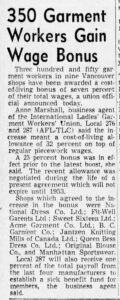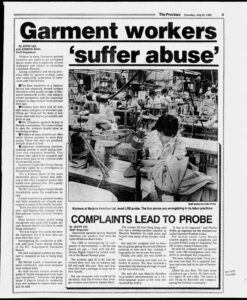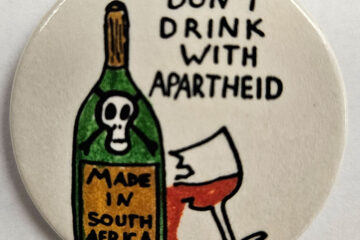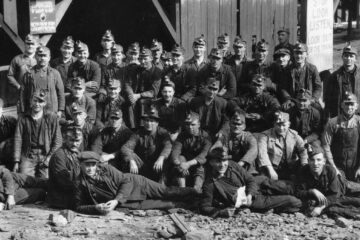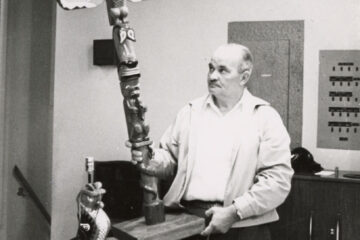Vancouver’s Garment Industry
Researched and written by Natasha Fairweather
Diving in to 100 Years of Garment Work
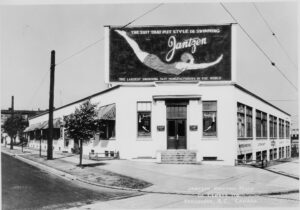
The Jantzen knitting factory with the iconic “diving girl” sign operated at 196 Kingsway from 1927 to 1997. Photo: Smithsonian Online Virtual Archives | NMAH-AC0233-0000004
The early 1900s was a time of rapid industrialization in Canada and around the world. Clothing production became mechanized, and garment workers – largely women, often immigrants from Europe – were subjected to inhumane conditions in assembly-line factories. The 1911 fire at the Triangle Shirtwaist Factory in New York was a particularly tragic outcome of these conditions and helped to draw attention to the need for reform.
Universal Knitting opened in Vancouver in 1915. It was located above the Granville Market on the corner of Granville and Smithe, and produced sweaters, coats, and swimwear. By 1917 they employed between 40-50 workers, “none but British help, mostly females, young men who have not attained military age, and ex-soldiers.”1
With a growing reputation and increasing demand, Universal Knitting required more space than the one room it had been operating from. In the spring of 1919, the company moved to the top two floors of the News-Advertiser building at 303 West Pender. 2 The bottom two floors were occupied by the Vancouver Daily Star.
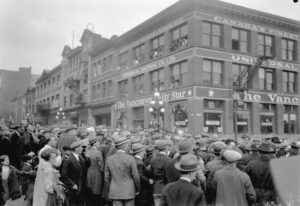
A crowd gathers in front of the building shared by Universal Knitting and The Vancouver Daily Star in 1926. This building still stands at the corner of West Pender St. and Hamilton St. Photo: City of Vancouver Archives | 99-1531
Inside, women workers sat in long rows, assigned work as machine operators and finishers, while men had jobs as knitters and supervisors. Garments were constructed in assembly-line style, and workers were paid on a piece-work basis, with separate rates based on gender.
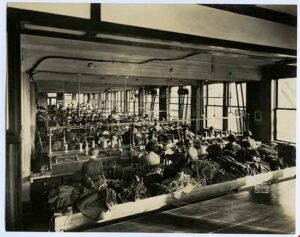
Inside the finishing room at the Universal Knitting Mill. Photo: Vancouver Public Library Archive | 21388
The company secured the right to produce swimwear for Jantzen in 1926, and soon found their facilities inadequate. The two sections of the company reincorporated under the Jantzen name in 1927 and moved to a new purpose-built facility at 196 Kingsway. 3
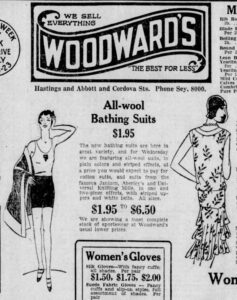
Universal Knitting and Jantzen’s advertised heavily across British Columbia. The Province, May 21, 1929
Ann Marshall (sometimes spelled “Anne”) started working at Jantzen in the 1930s. In her 1979 oral history interview with Sara Diamond, she recalled the working conditions at the time.4 Marshall explained that she had no problem with piecework when the rates were set in collaboration between the workers and the employer, but the Bedaux system used by Jantzen was another story. An early—and influential—efficiency system of the scientific management school, the Bedaux system reduced every task to miniscule units, timed workers to the second, and used averaging formulas to pay workers based on their lowest scores. “My gosh, you work as hard as you can work, and you don’t make your pay,” said Marshall “and then when you make it, they take it away from you.”
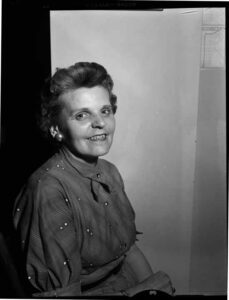
Ann Marshall was a seamstress, union organizer, and business agent for the International Ladies Garment Workers Union. Photo: Vancouver Public Library Archive | 62262
In the mid-1930s, during the depression era, employees at Jantzen organized into the International Ladies’ Garment Workers Union, Local 276 (Cloakmakers) and Local 287 (Sportswear). Ann Marshall was one of the union organizers and was eventually hired as business agent – a position she would hold for 16 years. News reports over the next several decades detail a string of friendly negotiations, pay raises, cost-of-living increases, and a revolutionary new pension scheme.
Marjorie Hamilton was another prominent garment manufacturer in Vancouver, starting in 1944 with a home business selling lingerie but quickly growing to a large workforce and modern machinery. By 1949, the Marjorie Hamilton factory on W. Pender in Vancouver had 35 employees operating electric machines.5
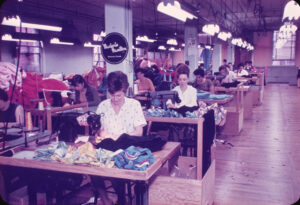
The Marjorie Hamilton factory on W. Cordova St, where a workforce of 200 women sewed dresses. Photo: City of Vancouver Archives | 810-248
Throughout this period, the workforce was changing. Until the 1960s, the garment industry typically employed European women, but shifted to hiring newly-arrived women from Asia, who often did not have the Canadian language and legal knowledge to advocate for their rights.
In 1985 The Province reported on “sweatshop conditions” at a number of Vancouver garment factories.6 Complaints varied from wage theft to verbal and physical abuse. The Chinese Benevolent Association launched an investigation, saying that Chinese women were “singled out” for abuse at work, but were too afraid of retaliation to make public claims.7 The staff at Marjorie Hamilton at the time was around 200, 95% of whom were Chinese.8
While the International Ladies Garment Workers Union agreed that Marjorie Hamilton was “one of the better shops,”8 it was still reported to the BC Human Rights Council for age discrimination. The factory had laid off older workers while advertising help-wanted in Chinese-language newspapers. They were found liable in several cases and forced to pay a fine.
Also in 1985 the International Ladies’ Garment Workers Union launched an organizing drive at Marjorie Hamilton. The employer responded by offering a benefits package, and the drive failed. They tried again in 1986 and after both sides contested votes and Employment Standards stepped in to adjudicate, the union won.
It took two and a half years to reach first contract, and that ratification meeting was reported by The Vancouver Sun with the headline “Deal sewn up in tiny turnout.”
A contract covering 175 employees at Marjorie Hamilton Ltd. was ratified Wednesday — by all four people who turned out to vote.
“We would have been pleased with a better turnout,” admitted Phyllis Webb, business agent and B.C. manager for the International Ladies Garment Workers Union.
[…]
She said the turnout did not reflect the support for the union’s position and the contract, but rather shows the fear of new union members who don’t want to antagonize their employer. 9
Marjorie Hamilton declared bankruptcy in 1995 and Jantzen closed its Vancouver factory in 1997. In 1995 The International Ladies Garment Workers Union merged with other clothing unions, and later with hospitality unions to form what is now known as UNITE-HERE.
The garment industry went underground.
The Vancouver Sun reported in 1997 on the growth of the home-garment trade – made up of “immigrant women, often Chinese-Canadians and Indo-Canadians, who speak little English and are often unaware of their rights to a minimum wage or overtime pay.” These workers sew at home, for piece work rates. They pay for their own supplies, have no job security or benefits, and are often threatened with retaliation if they speak to union organizers.
“We’re going back to the early 1900s,” said Vas Gunaratna of UNITE, the Vancouver garment workers’ union.
[…]
The union has had little luck organizing home-workers. “The contractors have got them so scared that for us it’s a really, really hard time,” said Gunaratna. “We have contractors saying ‘If you go to the union we’ll black list you,’ so they’re scared.” 10
Today, most garment workers in Canada are not unionized.
- From modest start forges up to front: Universal Knitting Company is now among leading firms of the continent. (1917, September 5). Vancouver Daily World[↩]
- Universal Knitting Co. Gets Larger Quarters. (1919, April 16). The Vancouver Sun[↩]
- Jantzen enters B.C. with big knitting factory: $250,000 preferred stock, with best backing, issued for Canadian plant. (1927, June 25). The Times Colonist[↩]
- Women’s Labour History Project Oral Histories: Anne Marshall. Vivo Media Arts. Retrieved April 9, 2024. from http://archive.vivomediaarts.com/anne-marshall[↩]
- Husband and wife team successful in local business. (1949, September 24). The Province[↩]
- Garment workers ‘suffer abuse. (1985, July 25). The Province[↩]
- Sweatshop conditions (1985, July 26). The Province[↩]
- Sweatshop claims anger plant owner. (1985, July 26). The Province[↩][↩]
- Deal sewn up in tiny turnout (1987, September 17). The Vancouver Sun[↩]
- It’s back to 1900s, union official claims. (1997, May 3) The Vancouver Sun[↩]
